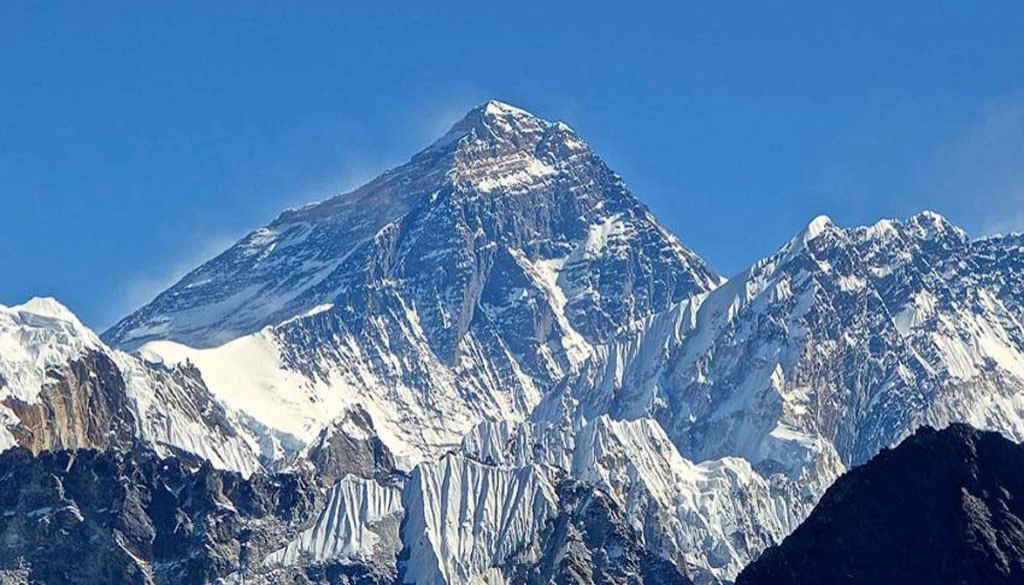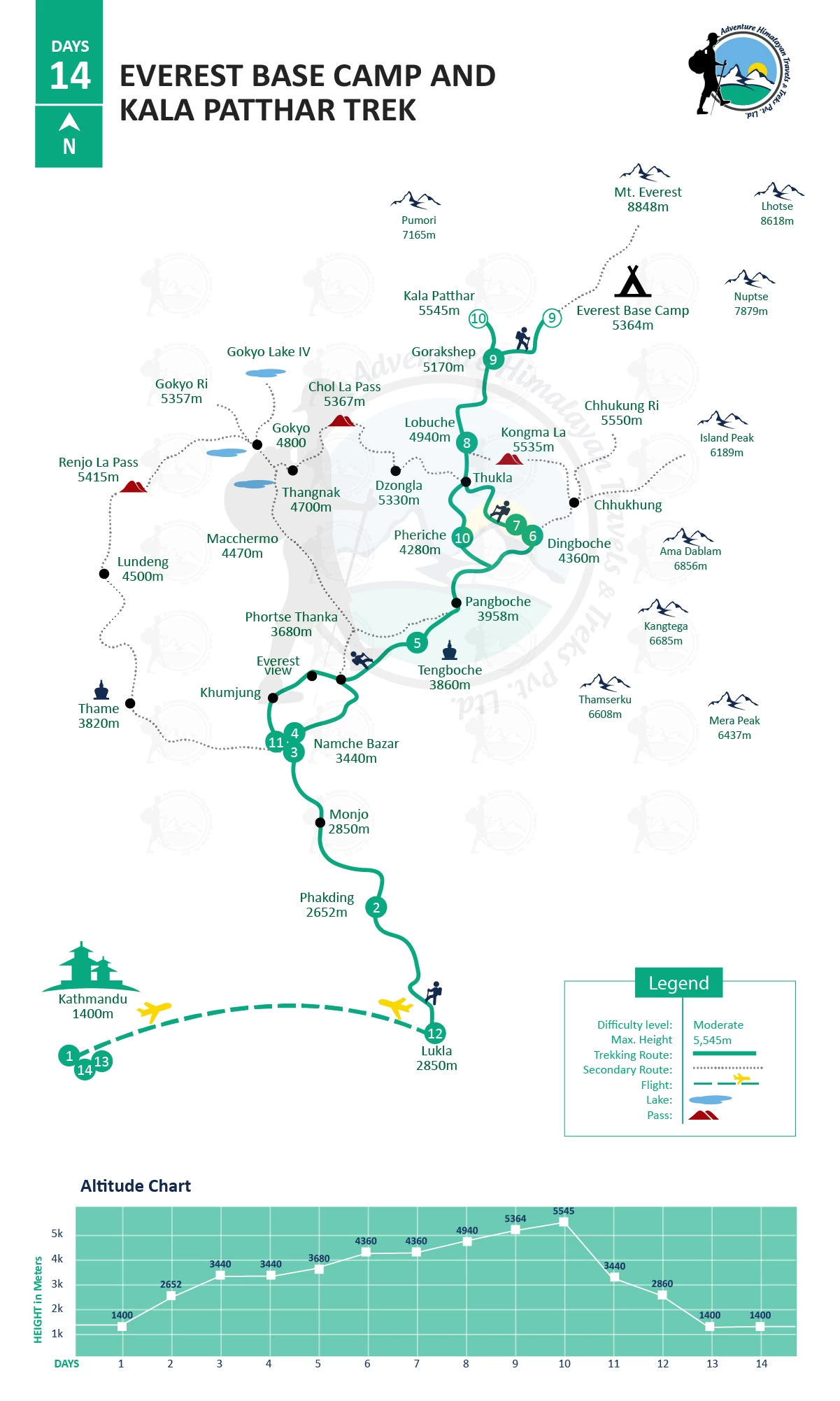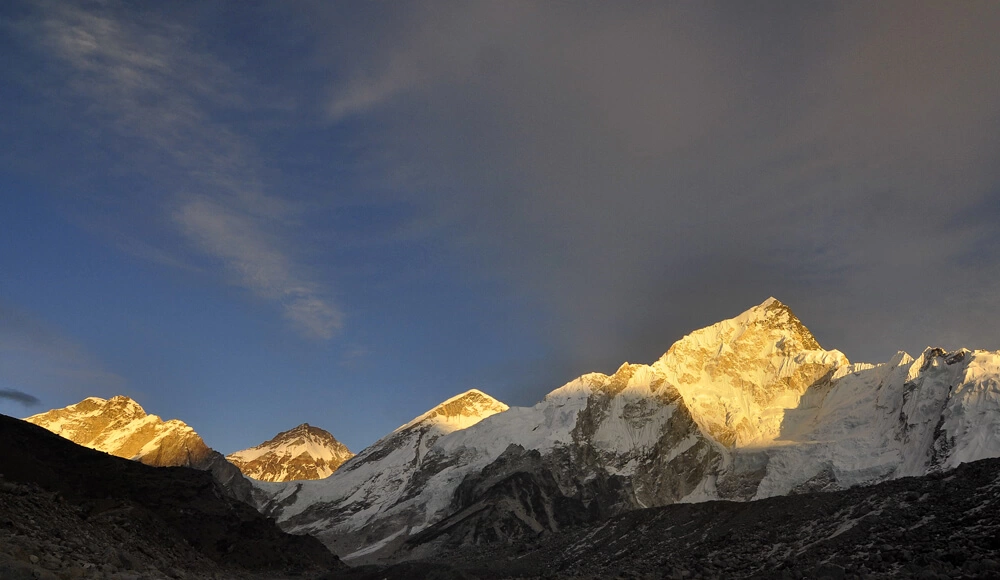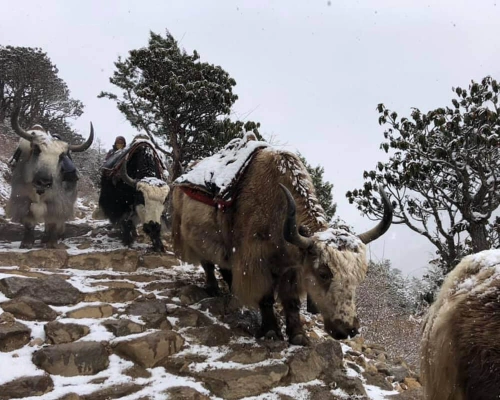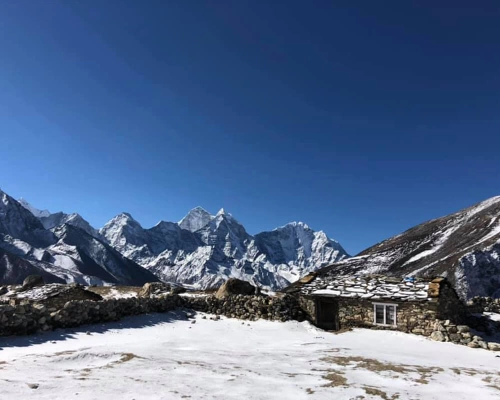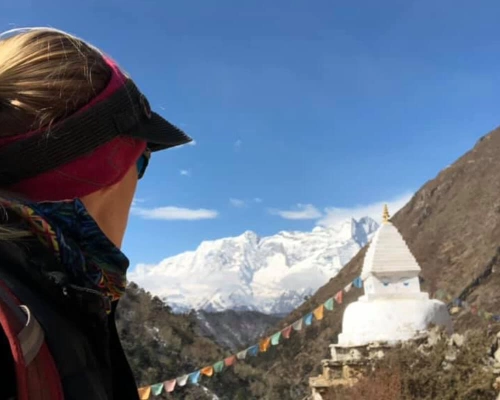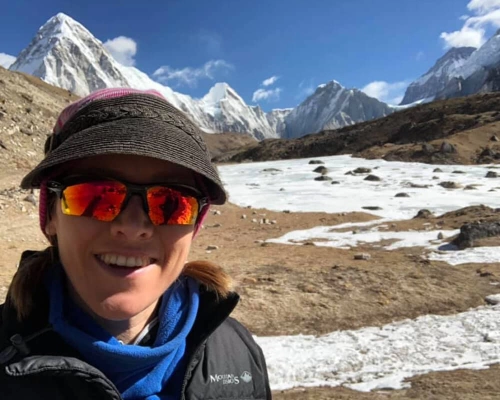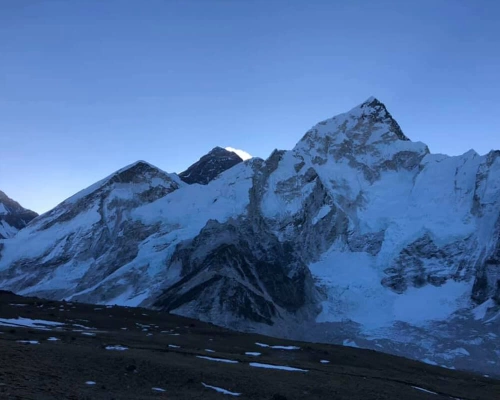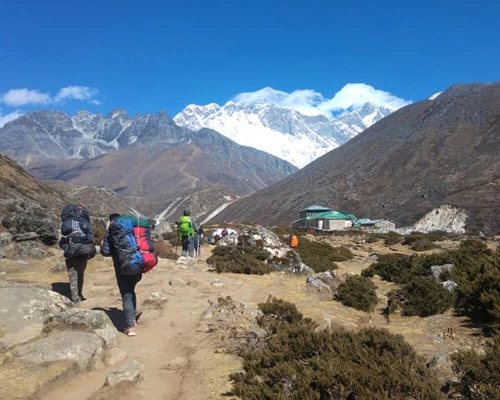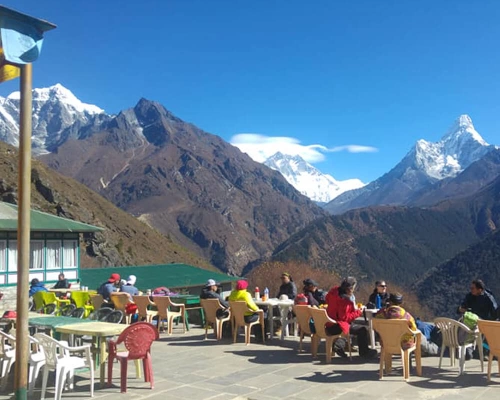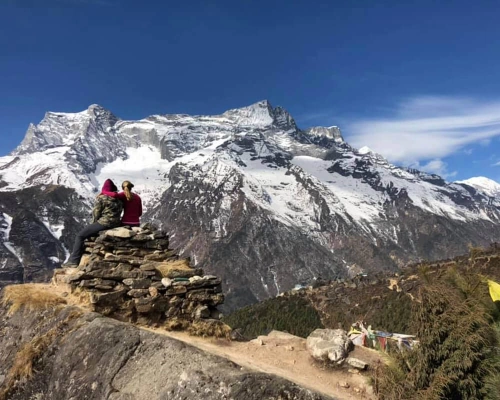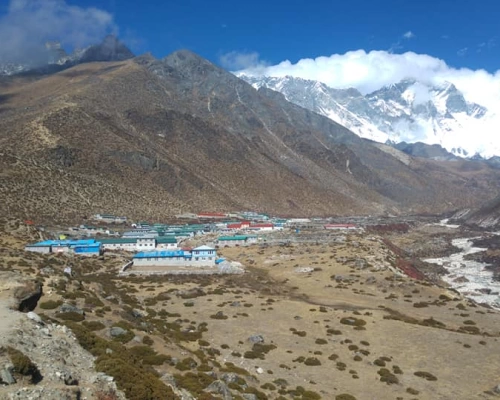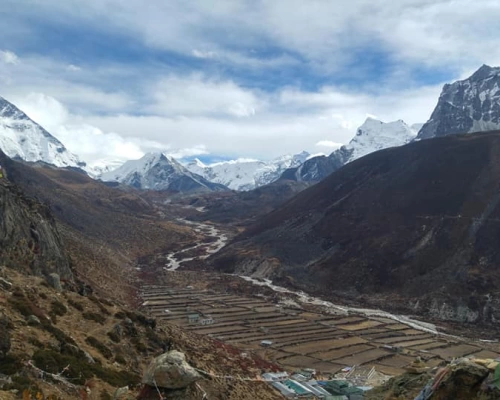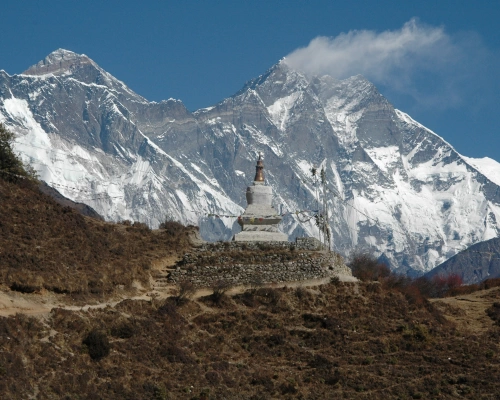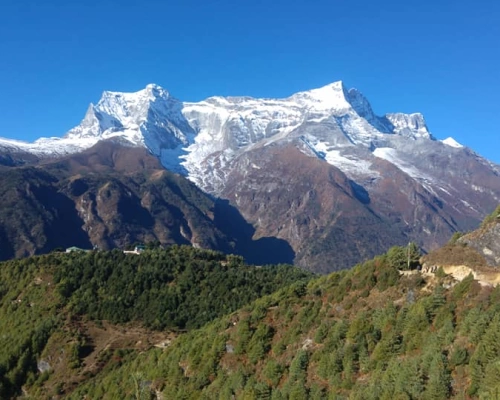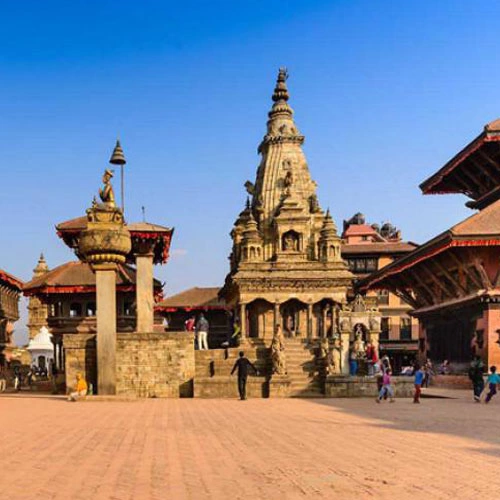The Everest Base Camp and Kala Patthar Trek is the world-famous epic Himalayan journey that reaches the base camp of the highest mountain in the world, Mt. Everest (8,848m). This adventurous rambling to the Everest region, otherwise also called the Khumbu Valley, is one such iconic venturing, tracing the footprints of the legends one can never get enough boasting about on making atop or just even in the lap of the tallest peak, Mt. Everest or the Sagarmatha.
Located in the mountainous realm of northeastern Nepal, the Everest region is home to a diverse range of flora and fauna watched over by some of the greatest grandeur nationally and internationally, such as Mt. Lhotse, Mt. Makalu, and Cho Oyu, including Mt. Everest (8,848 m) or Chomolungma in Tibet, after which the whole land is named after, serving as the haven for every mountaineer, trekker, and adventurer looking forward to unwinding themselves in the pristine ambiance of the Nepalese Himalayas that you won’t be able to help yourself fall in love completely during any sort of journey to the Everest Base Camp and equally adventurous Kala Patthar.
Further, the trekking route to explore the base camp of Everest and a side trek to Kala Patthar goes through one of the protected areas of Nepal called the Sagarmatha National Park, whose lower levels are dominated by silver, fir, birch, rhododendron, and juniper forests at 4,500 m, conserving some of the extremely elusive mammals such as the Himalayan tahr, musk deer, Himalayan black bear, red panda, and others in the alpine high Himalayas, crafting a visually stunning and diverse landscape, hence often the odyssey to the Everest Base Camp and Kala Patthar is referred to as the natural excursion to appreciate the mother nature and its mindblowing creations.
In addition, as a tea house trekking experience, during the journey to the Everest Base Camp and Kala Patthar, you will be spending nights at the various mountain lodges opened by the natives of the Himalayas, passing by some of the top-notch cultural landmarks as well, such as Namche Bazaar, Tengboche, Pangboche, Dingboche, and many others, reaching the highest altitude at Kala Patthar, providing a one-of-a-kind sight at the valley below and mountains perched above.
Hence, the Everest Base Camp and Kala Patthar Trek is an adventurous bucket list destination that has been the dreamland of every thrill lover across the world seeking amazing trekking trails, a unique cultural voyage, rich natural biodiversity, and the true sense of achievement of making it to the base camp of the world’s tallest peak, Mt. Everest, where each step leaves you in awe, corned by the mythical Himalayas of Nepal.
What to expect during the trek to the Everest Base Camp and side trip to Kala Patthar?
Undoubtedly trekking to the foothills of the top of the earth, Everest Base Camp, and Kala Patthar is rather a a physically and mentally demanding worthwhile adventure than a luxury holiday tour or travel, promising scenically abundant landscapes, awe-inspiring mountain views, and the ultimate opportunity to immerse yourself in the Himalayan culture, specifically that of a simpler but fulfilling culture of the Sherpa communities celebrated for their extraordinary coping ability to the arduous low oxygen level of the high Himalayas.
To conclude the combined trip to Everest Base Camp and Kala Patthar blends the excitement of adventure with the splendor of nature, cultural feasts, spiritual enlightenment, and a deep sense of accomplishment, making it a unique rambling that captures the hearts of explorers around the globe with:
The sensational flight to Lukla
Although there is an option of taking an overland trip to enter the Everest region, flying to the main gateway of the region, Lukla, is most convenient considering the duration, distance, time constraints, and potential landslides on the way.
Renowned for its short and sloppy runway, the airport Lukla, locally known as the Tenzing Hillary Airport, at an elevation of 527 m (1,729 ft), despite its reputation as one of the most challenging airports in the world, flying into it does ensure you breathtaking aerial views of the Himalayan landscapes featuring snow-covered peaks, deep valleys, rugged terrains, glaciers, cascading waterfalls, verdant hills, and others, providing a memorable introduction to the Khumbu region of Nepal.
Hence, the flight from Kathmandu to Lukla and vice versa is an experience in itself, unlike some of the flyovers you have ever indulged yourself in to land amidst the steep terrain and high mountains, including the Himalayas, adding much to the picturesque and adventurous setting during the Everest Base Camp and Kala Patthar Trek.
The iconic vistas of Mt. Everest
As the highest mountain giant in the world, Mt. Everest dominates the skyline throughout the trek to the Everest Base Camp and Kala Patthar, visible as soon as you hit the starting point, accompanied by some other prominent peaks in the region, including Lhotse (8,516 m/27,940 ft), Nuptse (7,861 m/25,791 ft), Ama Dablam, Cho Oyu (8,188 m/26,864 ft), Thamserku, and others striking trekkers and mountaineers with its rugged ridges and icy slopes.
These peaks are visible from various vantage points along the trekking trail leading to the base camp of Everest, especially from the Hotel Everest View, the base camp itself, and the highly elevated viewpoint of Kala Patthar after making way past several steep ascents and descents. These all come together to form an incredible backdrop at every turn you take in the corner of the Himalayas, making the voyage to the Everest Base Camp and Kala Patthar a surreal holiday destination that at least once must be traversed.
The outstanding Himalayan panorama from Kala Patthar
Located above the pastureland of Gorak Shep, Kala Patthar is one of the major highlights of the Everest Base Camp and Kala Patthar Trek, offering one of the best views of the Everest range dominating the entire horizon and the Khumbu Glacier to ascend early in the morning to witness the changing colors of the sky while the first ray of sun meets Everest peak and paints the surroundings with hues of pink, orange, and golden against the contrasting backdrop of the dark sky.
Moreover, Kala Patthar provides trekkers with an insider closet and dramatic view of Mt. Everest without actually having to climb the summit at an altitude of approximately 5,643m/18,514ft to capture in your camera lens, along with the constantly evolving light and weather conditions with drifting in and out clouds and unparalleled views of Lhotse, Nuptse, and Pumori on ascending steeply from Gorak Shep at high altitude, ensuring a sense of accomplishment upon reaching the ridge named Kalo Dhunga, or black stone in English, apparently due to the visibly black appearance of the stone that you will clamber during your mingled trek to the Everest Base Camp and Kala Patthar.
Visit to the spiritual hubs of the Everest Region, Tengboche, Pangboche, and Dingboche
On the trekking route to the Everest Base Camp and Kala Patthar lie three of the noteworthy historical, cultural, and religious monuments called Tengboche, Pangboche, and Dingboche, named after the associated monasteries encompassed, where Tengboche stands out as the largest Buddhist gompa of the region, Pangboche as the most ancient one, and Dingboche as the Sherpa village, providing unique engrossing enlightenment on the region's harmonious life sharing root with nature and its grandeur.
All of these three: Tengboche, Pangboche, and Dingboche exude a tactile and spiritual atmosphere, usually housing religious artifacts dating centuries back, including Thanka, statues of Buddhist deities, sacred scriptures, Mani walls, and Chhortens inscribed with prayers and mantra stones generally adorned with vibrant prayer flags fluttering in the crispy breeze with profound serene energy flowing, setting the perfect destination to mediate, self-reflect, learn, and appreciate the simpler yet warming mountainous life of Sherpa and other Himalayan locals in the remote realm untouched by rapid urbanization to relish to the fullest as you make to the Everest Base Camp and Kala Patthar.
The Everest Base Camp and acute mountain sickness
Situated at an altitude of approximately 5,364m/17,598ft on the Khumbu Glacier near the foot of Mt. Everest’s southern face, the Everest Base Camp (EBC) is the primary campsite used by climbers before summiting Mt. Everest as a starting point embodying the spirit of raw Himalayan exploration, perseverance, and teamwork for mountaineers, clambering which gives trekkers an equivalent satisfaction of being atop the highest peak in the world while seeing some of the symptoms of acute mountain sickness (AMS) or altitude sickness is normal that can be prevented on adequately acclimatizing, hydrated, physically and mentally prepared for this amazingly adventurous expedition to the Nepalese Himalayas.
As you ascend gradually, venturing deep into one of the UNESCO world’s heritage sites, the Sagarmatha National Park, without a doubt, there will be some humbling trek sections as you move closer and closer to the Everest Base Camp (EBC) and Kala Patthar, including some rugged terrain, steep uphill and downhill, and sudden weather change testing your physical stamina, mental resilience, and determination constantly devoid of everyday modern amenities. Here is where it is crucial to note that these are what make the Everest Base Camp and Kala Patthar Voyage the most memorable journey that comes once in a lifetime.
14 Days Itinerary for joint trekking to the Everest Base Camp and Kala Patthar
According to your 14-day itinerary for the Everest Base Camp and Kala Patthar Trek, your journey starts with a spectacular 25–45 minute flight from Kathmandu to Lukla, where Lukla serves as the starting and ending point of your overall voyage. From Lukla, you will take an ascending hike to the local tea house of Phakding, marking the official marking in the Khumbu region of Nepal to enter the Sagarmatha National Park Area the very next day making it to the hustling and bustling Sherpa town of the region, Namche.
Elevated at an altitude of 3,440m at Namche, it is crucial to let your body acclimate well to the mountainous surroundings for a better highland experience; hence, you will use the fourth day to completely engage yourself in the Namche exploration and profound resting and head for Tengboche, Dingboche, and Lobuche simultaneously. In between this 14-day itinerary for trekking, the Everest Base Camp and Kala Patthar have allocated another day to let your body absorb thoroughly at Dingboche after Namche.
Nonetheless, in around a week, you would make a steep ascent to the Base Camp of Everest, making your way through the verdant valleys of Gorak Shep to again ascend steeply to the highest altitude of the entire Everest Base Camp expedition, Kala Patthar, the following day to watch the magical glow on the highest peak in the world, Mt. Everest (8,848 m), and others, providing an all-round 360-degree insight into the whole region, and return to Pheriche for the night.
From Pheriche, you will directly descend to Namche to retrace the route back to Kathmandu, passing by Pangboche and Tengboche to catch an early morning flight from Lukla the next day, which denotes the end of the 14-day package to the Everest Base Camp and Kala Patthar with Adventure Himalayan Travels and Treks, where our airport representative will transport you to the Tribhuvan International Airport on your last day in the country of hills and mountains, Nepal, wishing you a safe flight.
This specific route to go for an adventurous expedition to the Everest Base Camp and Kala Patthar provides balanced trekking, acclimatization, cultural, and natural experiences without having to rush your pace, minimizing the risk of altitude sickness, which is still flexible with the itinerary customization, the 14-day itinerary and route to venture to the Everest Base Camp combined to Kala Patthar is considered to be the best one.
Group Discounted Cost for the trek to The Everest Base Camp (EBC) and Kala Patthar
Although USD 1575 is the standard package cost for the 14-day itinerary to the Everest Base Camp and Kala Patthar carefully crafted by Adventure Himalayan Travels and Treks, the overall cost to go for this adventurous journey can drop significantly to only USD 1275 per person a group trip consisting of 7–10 pax.
Hence, it can be concluded that the Everest Base Camp expedition combined with the side exploration to Kala Patthar cost can range anywhere from USD 1275 to USD 1575 per person depending upon the group size, which again can experience variation in adding or subtracting the trek days along with the level of services on food and accommodation, whether you have chosen to hire guides and porters or not.
Here is a brief overview of how much the epic cultural and natural voyage to the Everest Base Camp and Kala Patthar can cost you, which normally covers the expenses of major trekking logistics, including meals, accommodation, domestic flight tickets, permits, guides, and porter fees, along with the necessary insurance, gear, and equipment.
- USD 1,575 for 1 pax
- USD 1,375 for 2-3 pax
- USD 1,325 for 4-6 pax
- USD 1,275 for 7-10 pax
